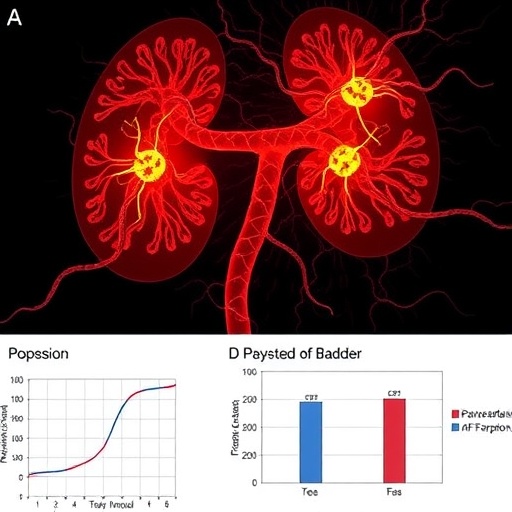
In the relentless pursuit to decipher the molecular underpinnings of bladder cancer, a groundbreaking study has unveiled a pivotal role of the transcription factor TCF3 in orchestrating tumor progression through a novel ferroptosis-dependent pathway. Researchers led by Yang WF and colleagues have illuminated how TCF3 exacerbates bladder cancer development by modulating the TMBIM6-Ca²⁺ axis, intricately linking transcriptional regulation with iron-dependent cell death mechanisms. This discovery not only broadens our understanding of bladder carcinogenesis but also opens unprecedented avenues for therapeutic intervention targeting ferroptosis modulation.
Bladder cancer stands as one of the most prevalent malignancies affecting the urinary tract, with limited effective treatment options, especially in advanced stages. The complexity of its molecular landscape has long challenged scientists, necessitating a deeper exploration of the pathways fueling tumor growth and resistance. In this context, the transcription factor TCF3 emerges as a master regulator whose dysregulation disrupts cellular homeostasis and promotes oncogenic signaling.
TCF3, known for its role in early developmental processes and stem cell maintenance, has now been implicated in cancer through its ability to regulate gene networks governing cell survival and death. The study demonstrates that upregulation of TCF3 in bladder cancer cells leads to enhanced expression of TMBIM6 (Transmembrane Bax Inhibitor Motif-containing 6), a critical modulator of intracellular calcium flux and apoptotic resistance. This regulatory axis is identified as a key driver in the tumor’s evasion of canonical cell death pathways.
.adsslot_ielb2sXqFK{width:728px !important;height:90px !important;}
@media(max-width:1199px){ .adsslot_ielb2sXqFK{width:468px !important;height:60px !important;}
}
@media(max-width:767px){ .adsslot_ielb2sXqFK{width:320px !important;height:50px !important;}
}
ADVERTISEMENT
The crux of the study revolves around ferroptosis, a distinctive form of regulated cell death characterized by iron-dependent lipid peroxidation. Unlike apoptosis or necrosis, ferroptosis presents a unique vulnerability within cancer cells, particularly those with dysregulated iron metabolism and reactive oxygen species (ROS) homeostasis. Crucially, TCF3’s control over TMBIM6 alters cellular calcium signaling dynamics, instigating a ferroptotic environment that paradoxically enables tumor cells to survive and flourish under metabolic stress.
Probing deeper into the molecular circuitry, the investigators revealed that TMBIM6 regulates intracellular Ca²⁺ concentrations, which in turn modulate lipid peroxidation processes central to ferroptosis. Elevated calcium levels influence mitochondrial function and the generation of lipid ROS, thereby dictating the ferroptotic threshold. TCF3’s promotion of TMBIM6 expression effectively reprograms cancer cells’ ferroptotic susceptibility, tipping the balance in favor of tumor progression rather than cell death.
Advanced transcriptomic and proteomic analyses substantiated the relationship between TCF3, TMBIM6, and calcium-dependent ferroptosis pathways. Employing CRISPR-Cas9 gene editing and ferroptosis-specific inhibitors, the research delineated how disruption of this axis sensitizes bladder cancer cells to ferroptotic death, diminishing their proliferative and invasive capacities. These findings signify a promising therapeutic strategy—targeting the TCF3-TMBIM6 axis to restore ferroptotic sensitivity and impede tumor growth.
The implications extend beyond bladder cancer, as TCF3 and TMBIM6 are broadly expressed across various tissues and tumor types. The study sets a precedent for investigating ferroptosis modulation by transcription factors in other malignancies, potentially heralding a new paradigm in cancer treatment. By manipulating calcium signaling and iron-dependent lipid peroxidation, clinicians could harness ferroptosis as a lethal weapon against resistant cancer cells.
Moreover, this research underscores the intricate crosstalk between transcriptional regulation and metabolic cell death mechanisms. It reveals that ferroptosis, once considered a niche phenomenon, is intricately woven into oncogenic networks, influenced by transcription factors that regulate pivotal genes like TMBIM6. Such insights compel a re-examination of cancer biology, accentuating the multifaceted roles of transcription factors beyond gene expression to include metabolic and cell death modulation.
The study’s methodological rigor further strengthens its conclusions. Sophisticated in vitro and in vivo models recapitulated the ferroptotic pathway’s dynamics under genetic and pharmacological manipulation. The use of patient-derived bladder cancer samples validated the clinical relevance of TCF3 and TMBIM6 expression patterns, linking high levels with poorer prognosis and increased tumor aggressiveness. This correlation emphasizes the potential of TCF3 as a biomarker for disease stratification and treatment response.
Intriguingly, the research also highlights the therapeutic potential of combining ferroptosis inducers with conventional chemotherapeutics. Such combination therapies may exploit the metabolic vulnerabilities conferred by TCF3-driven ferroptosis modulation, overcoming resistance mechanisms that plague current treatment regimens. Future clinical trials informed by these mechanistic insights could transform bladder cancer management, enhancing survival outcomes.
However, the complexity of ferroptosis regulation necessitates caution in translating these findings. The dualistic role of ferroptosis in cancer—as both a suppressor and promoter depending on context—requires a nuanced understanding to avoid unintended consequences. The modulation of calcium signaling and iron metabolism, although promising, demands precise targeting to minimize off-target effects and toxicity in normal tissues.
In light of these findings, it becomes evident that integrating molecular diagnostics with targeted therapies will be essential to harness the full potential of ferroptosis-based interventions. Personalized medicine approaches incorporating TCF3 and TMBIM6 expression profiling could refine patient selection, tailoring treatments to exploit the ferroptotic vulnerabilities unique to each tumor’s molecular makeup.
Looking ahead, further research should dissect the interplay between TCF3, ferroptosis, and the tumor microenvironment, exploring how immune cells and stromal components influence and respond to ferroptotic signals. Understanding this cellular crosstalk will be critical for developing combinatorial strategies that synergize ferroptosis induction with immunotherapy, potentially unleashing a robust anti-tumor immune response.
In conclusion, the identification of TCF3 as a driver of bladder cancer progression via TMBIM6-Ca²⁺-dependent ferroptosis represents a paradigm-shifting advancement in cancer biology. By elucidating a novel molecular axis that reprograms cell death susceptibility, this study lays the groundwork for innovative therapeutic approaches harnessing the power of ferroptosis. It invites the scientific community to rethink the traditional boundaries of transcription factor functions and embrace the interplay between gene regulation, metabolism, and cell fate as a fertile ground for cancer treatment discovery.
Subject of Research: The role of transcription factor TCF3 in promoting bladder cancer development through modulation of TMBIM6 and calcium-dependent ferroptosis mechanisms.
Article Title: Transcription factor TCF3 promotes bladder cancer development via TMBIM6-Ca²⁺-dependent ferroptosis.
Article References:
Yang, WF., Guo, WM., Luo, QT. et al. Transcription factor TCF3 promotes bladder cancer development via TMBIM6-Ca²⁺-dependent ferroptosis. Cell Death Discov. 11, 303 (2025). https://doi.org/10.1038/s41420-025-02585-8
Image Credits: AI Generated
DOI: https://doi.org/10.1038/s41420-025-02585-8
Tags: bladder cancer progression mechanismsbladder cancer treatment optionsdysregulation of cellular homeostasisferroptosis in canceriron-dependent cell deathmolecular mechanisms of carcinogenesisoncogenic signaling pathwaysrole of TCF3 in tumor growth.TCF3 in bladder cancertherapeutic targets in bladder cancerTMBIM6-Ca2+ axistranscription factors and cancer





